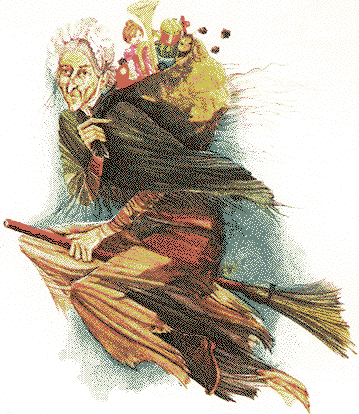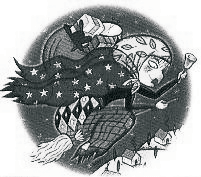|
|
| |
| La
Befana: The Witch of Christmas |
| By
Il Postino Staff and Tessa Derksen |
 |
The
legend of Befana began thousands of years ago and remains to this day
a tradition practised by Italian children and their families. As the
story goes, one day, the three Magi left their country bearing special
gifts of gold, incense and myrrh for the new-born Jesus Christ. They
were guided by a star across many countries. At every village that they
passed, people ran to meet them and accompany them in their journey.
But there was one old woman who did
not join the Magi. She claimed to be too busy with her housework and
promised to join them later when she had time. The next day, she realized
her mistake and frantically ran after the Magi with gifts for the
child, still clutching her broom. But it was too late – the
Magi were long gone.
|
|
Ever since then the old woman has
been known as “La Befana” or simply “Befana.”
On the eve of January 6th, Befana flies from house to house on her
old broomstick and delivers all the gifts she didn’t give to
the Holy Child to good girls and boys.
|
In
fact, Befana’s name is the Greek word “epifania”
or “epiphany,” and is significant because the religious
feast of the Epiphany is celebrated on January 6th. This Christian
celebration, in remembrance of the Magi’s visit to Jesus, can
include purifying rites and benedictions with water. Water prepared
on the eve of the Epiphany (the night that Befana flies the skies)
is said to have sacred properties that can ward off evil spirits and
is used in critical moments of a family’s life. Celebration
of the Epiphany can be traced as far back as the 13th century and
is one of the most popular Italian feasts. |
 |
|
In
the time when our grandparents were children, Befana was tremendously
popular and was awaited with a mixture of joy and anxiety. Children
hung hand-knitted stockings on the fireplace and wrote long letters
to her expressing their wishes. Often they were disappointed as their
families had little money to spend on gifts; however, sometimes they
found little hand-sewn dolls and puppets in their stocking. If they
had been bad, their stockings were filled with onions, garlic and
coal. Although there were no traditional dishes to celebrate this
day, people would gather together and eat chestnuts, nuts and fruit
pancakes.
|
Children
of today know Befana as an old woman who flies a broom and wears a
black shawl over a dress dirty with soot from the chimneys she climbs
down to deliver her gifts. For the good children she brings sweets,
toys and books. And, as in the past, she brings onions, garlic and
coal for the bad children. In modern-day Italy some shops sell carbone
or black rock candy that actually looks like pieces of coal.
Many people believe in La Befana’s existence, while others believe
it is a fanciful story created for children. But Befana’s question
of existence is irrelevant. Either way she still fulfils her function,
which is to reaffirm the bond between family and ancestors through
an exchange of gifts.
|
Chant
Used by Italian Children
(from
www.fabrisia.com/befana.htm)
La
Befana comes at night
In tattered shoes
Dressed in the Roman style
Long live la Befana!!
She
brings cinders and coals
To the naughty children
To the good children
She brings sweets and lots of gifts.
|
| |
|
| back
to the top |
|


